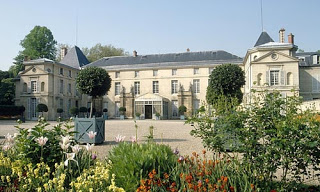Walking past the Rose Corner in Ladywell led Mike Guilfoyle, vice-chair of the Friends of Brockley and Ladywell Cemeteries, to ponder an historical link to Napoleon and Empress Josephine whose favourite plant was the rose.

Over the festive season I recall passing the Rose Corner in Ladywell with some of its fine bundles of floral bouquets on display.
I kept turning over in my head an overlooked but fascinating historical local link to a former age when Empress Josephine Bonaparte (she married Napoleon Bonaparte in 1796), whose favourite plant was the rose, built her rose collection between the years 1804 and 1814. It became the greatest and largest rose collection in the world.
In 1799, while Napoleon was away fighting the Egyptian Campaign, Josephine had bought Malmaison, a chateau just outside of Paris (see photo).
By 1830 some 2,500 different rose varieties would be available to Parisian rose lovers, all influenced by Josephine’s zeal for rose collecting.
Malmaison became the couple’s country retreat. After her divorce from Napoleon in 1809, she obtained sole ownership.
Not even the Napoleonic wars would prevent new plants – especially roses – from reaching Malmaison.
English gardeners were issued passports and even granted safe passage through military blockades if they were transporting acquisitions for Her Imperial Majesty.
Her principal source for roses was the Lee & Kennedy Vineyard Nursery in London. Josephine wanted every rose known in the world, and in 1804, by way of Lewis Kennedy, she was in proud possession of the new Chinese roses: Slater’s Crimson China, Parson’s Pink and Hume’s Blush Tea Scented China.
These ever blooming roses were recent imports to England from China, and it was a coup for the Empress (and for France) to have them growing at Malmaison. They became known as stud roses, potent parents of the modern ever blooming rose cultivars.

Josephine’s truly remarkable life is well told in Andrea Stuart’s much acclaimed 2005 book – The Rose of Martinique.
Born in Martinique, her name was Rose when she arrived in France at age 15 to marry her first husband.
Rose matured and built alliances in unlikely places, including the convent where her husband forced her to retire and the prison where she spent the last months of the French Revolution.
It was after this period and her husband’s execution that she became one of Paris’s great hostesses and attracted the attention of a rising military hero named Napoleon Bonaparte.
The first years of marriage, when letters of the often-absent, sexually inexperienced Napoleon raged with jealousy while Rose, whom he renamed Josephine, continued to have the affairs common in her social circle.
Some historians have argued that the emperor’s harsh treatment of women in the Code Napoleon reflected the dynamics and frustrations of his own marriage.
Lee and Kennedy were two families of prominent Scottish nurserymen in partnership for three generations at the Vineyard Nursery in Hammersmith.
“For many years,” wrote the man described as the ‘father of the English garden John Claudius Loudon in 1854, “this nursery was deservedly considered the first in the world.”

Lewis Kennedy (1789 -1887) had worked in the family business as a young man at Malmaison. He also designed numerous gardens in the new, formal style, including gardens at Chiswick House and worked with the famous architect and landscape designer Sir Charles Barry.
Which brings me to the Ladywell link.
Born in 1822, the son of Lewis Kennedy, George Penrose Kennedy worked as an architect.
His father secured for his son a place in the office of Sir Charles Barry, perhaps best known for his role in the rebuilding of the Houses of Parliament.
George eventually retired to Sunnyside, Dermody Road, Lewisham. He died there in 1894 and was interred in Ladywell cemetery.
His widow, Kate Butler Kennedy died in 1939 and is buried in the same plot. A recent search for the actual grave site in Ladywell cemetery led to me an unmarked grassy space but absent any extant headstone.
George’s roseate family story has offered quite a backstory for any guided walk!
For a fuller biographical outline of his architectural achievements see attached – (although date of George’s death inaccurate)
http://www.scottisharchitects.org.uk/architect_full.php?id=200696
Footnote: Another intriguing link to Revolutionary France is the nearby grave of the Reverend Canon Walter Allen Moberly (d.1905) Vicar of St Bartholomew’s Church, Sydenham. One of his sisters, Charlotte, was the first principal of St. Hugh’s College, Oxford. Her successor as principal was Eleanor Frances Jourdain. When the pair visited the Petit Trianon, at the Palace of Versailles in 1901 (which happened to be the anniversary of the sacking of the Tuileries Royal Palace in 1792) they underwent a psychic time slip experience, in which they claimed to have seen Queen Marie Antoinette painting in the garden, about which the pair wrote a book ‘An Adventure’ published in 1931, which is said to have influenced Frodo’s dreams in’ The Lord of the Rings’ !This famous ghost sighting was the subject of the 1981 supernatural Television drama Miss Morison’s Ghosts’ https://vimeo.com/125628236
